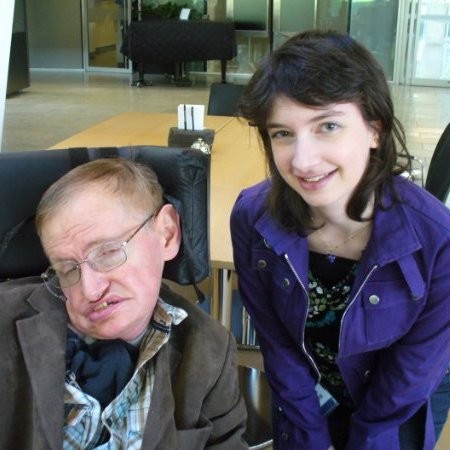
Miriam Diamond
- Courses14
- Reviews27
- School: University of Toronto
- Campus: St. George Campus
- Department: Geography
- Email address: Join to see
- Phone: Join to see
-
Location:
Toronto, ON - Dates at University of Toronto: December 2004 - February 2020
- Office Hours: Join to see
Biography
University of Toronto St. George Campus - Geography
Assistant Professor of Astroparticle Physics at University of Toronto
Research
Miriam
Diamond
Toronto, Ontario, Canada
Being a physicist is about pursuing our understanding of the universe at its most fundamental level. Now that the cornerstone of the Standard Model has fallen into place with the discovery of the Higgs Boson, it's time to shed some light on the "dark matter" that makes up approximately a quarter of the universe. This is the greatest treasure hunt ever undertaken!
Experience
Carleton University
Research Assistant
- Calibration of liquid-argon forward calorimeters for LHC ATLAS
- Higgs phenomenology
- Data analysis for Sudbury Neutrino ObservatoryUniversity of Toronto
Research and Teaching Assistant
Research in experimental high-energy particle physics with the LHC ATLAS collaboration, specializing in dark matter searches. Teaching assistant for undergraduate physics courses.
University of Toronto
The PGSA holds networking, social, and academic-oriented events for physics graduate students at the University of Toronto.
University of Toronto
Graduate students, post-docs, and faculty members provide undergraduate physics majors with academic, career, and life-skills guidance through the department's mentorship program.
Arthur B. McDonald Canadian Astroparticle Physics Research Institute
Assistant Professor
My primary research area is low-mass dark matter searches, as a member of the SuperCDMS direct-detection experiment at SNOLAB.
Perimeter Institute
PSIon
PSIon: member of Perimeter Scholars International. (Although I do also have a certain fondness for psi-mesons.) Research specialized in low-mass dark matter and Beyond the Standard Model gauge forces.
Stanford Linear Accelerator Center
Experimental Research Associate
Detector development, data acquisition, and data analysis for the Heavy Photon Search (HPS) experiment
Education
Carleton University
Bachelor of Science (BSc)
Physics
Carleton University
Research Assistant
- Calibration of liquid-argon forward calorimeters for LHC ATLAS - Higgs phenomenology - Data analysis for Sudbury Neutrino ObservatoryUniversity of Toronto
Doctor of Philosophy (Ph.D.)
Elementary Particle Physics
Experimental high-energy particle physics: dark matter searches at LHC ATLASUniversity of Toronto
Research and Teaching Assistant
Research in experimental high-energy particle physics with the LHC ATLAS collaboration, specializing in dark matter searches. Teaching assistant for undergraduate physics courses.University of Toronto
The PGSA holds networking, social, and academic-oriented events for physics graduate students at the University of Toronto.University of Toronto
Graduate students, post-docs, and faculty members provide undergraduate physics majors with academic, career, and life-skills guidance through the department's mentorship program.University of Waterloo
Master of Science (MS)
Physics
Completed Perimeter Scholars International, a joint program between the University of Waterloo and the Perimeter Institute for Theoretical Physics.
Publications
Searching for Light Dark Matter with the SLAC Millicharge Experiment
Physical Review Letters
New sub-GeV gauge forces ("dark photons") that kinetically mix with the photon provide a promising scenario for MeV-GeV dark matter, and are the subject of a program of searches at fixed-target and collider facilities around the world. In such models, dark photons produced in collisions may decay invisibly into dark matter states, thereby evading current searches. We re-examine results of the SLAC mQ electron beam dump experiment designed to search for millicharged particles, and find that it was strongly sensitive to any secondary beam of dark matter produced by electron-nucleus collisions in the target. The constraints are competitive for dark photon masses in the ~1-30 MeV range, covering part of the parameter space that can reconcile the apparent (g-2)_{\mu} anomaly. Simple adjustments to the original SLAC search for millicharges may extend sensitivity to cover a sizable portion of the remaining (g-2)_{\mu} anomaly-motivated region. The mQ sensitivity is therefore complementary to on-going searches for visible decays of dark photons. Compared to existing direct detection searches, mQ sensitivity to electron-dark matter scattering cross sections is more than an order of magnitude better for a significant range of masses and couplings in simple models.
Searching for Light Dark Matter with the SLAC Millicharge Experiment
Physical Review Letters
New sub-GeV gauge forces ("dark photons") that kinetically mix with the photon provide a promising scenario for MeV-GeV dark matter, and are the subject of a program of searches at fixed-target and collider facilities around the world. In such models, dark photons produced in collisions may decay invisibly into dark matter states, thereby evading current searches. We re-examine results of the SLAC mQ electron beam dump experiment designed to search for millicharged particles, and find that it was strongly sensitive to any secondary beam of dark matter produced by electron-nucleus collisions in the target. The constraints are competitive for dark photon masses in the ~1-30 MeV range, covering part of the parameter space that can reconcile the apparent (g-2)_{\mu} anomaly. Simple adjustments to the original SLAC search for millicharges may extend sensitivity to cover a sizable portion of the remaining (g-2)_{\mu} anomaly-motivated region. The mQ sensitivity is therefore complementary to on-going searches for visible decays of dark photons. Compared to existing direct detection searches, mQ sensitivity to electron-dark matter scattering cross sections is more than an order of magnitude better for a significant range of masses and couplings in simple models.
A Search for Astrophysical Burst Signals at the Sudbury Neutrino Observatory
Astroparticle Physics
The Sudbury Neutrino Observatory (SNO) has confirmed the standard solar model and neutrino oscillations through the observation of neutrinos from the solar core. In this paper we present a search for neutrinos associated with sources other than the solar core, such as gamma-ray bursters and solar flares. We present a new method for looking for temporal coincidences between neutrino events and astrophysical bursts of widely varying intensity. No correlations were found between neutrinos detected in SNO and such astrophysical sources.
Searching for Light Dark Matter with the SLAC Millicharge Experiment
Physical Review Letters
New sub-GeV gauge forces ("dark photons") that kinetically mix with the photon provide a promising scenario for MeV-GeV dark matter, and are the subject of a program of searches at fixed-target and collider facilities around the world. In such models, dark photons produced in collisions may decay invisibly into dark matter states, thereby evading current searches. We re-examine results of the SLAC mQ electron beam dump experiment designed to search for millicharged particles, and find that it was strongly sensitive to any secondary beam of dark matter produced by electron-nucleus collisions in the target. The constraints are competitive for dark photon masses in the ~1-30 MeV range, covering part of the parameter space that can reconcile the apparent (g-2)_{\mu} anomaly. Simple adjustments to the original SLAC search for millicharges may extend sensitivity to cover a sizable portion of the remaining (g-2)_{\mu} anomaly-motivated region. The mQ sensitivity is therefore complementary to on-going searches for visible decays of dark photons. Compared to existing direct detection searches, mQ sensitivity to electron-dark matter scattering cross sections is more than an order of magnitude better for a significant range of masses and couplings in simple models.
A Search for Astrophysical Burst Signals at the Sudbury Neutrino Observatory
Astroparticle Physics
The Sudbury Neutrino Observatory (SNO) has confirmed the standard solar model and neutrino oscillations through the observation of neutrinos from the solar core. In this paper we present a search for neutrinos associated with sources other than the solar core, such as gamma-ray bursters and solar flares. We present a new method for looking for temporal coincidences between neutrino events and astrophysical bursts of widely varying intensity. No correlations were found between neutrinos detected in SNO and such astrophysical sources.
Search for long-lived neutral particles decaying into displaced lepton jets in proton--proton collisions at √s = 13 TeV with the ATLAS detector
38th International Conference on High Energy Physics
This note presents the results of a search for long-lived neutral particles decaying into collimated jets of light leptons and mesons, so-called "lepton-jets", using a sample of 3.4/fb of proton-proton collisions data at a centre-of-mass energy of √s=13TeV collected during 2015 with the ATLAS detector at the LHC.
Possible Matching Profiles
The following profiles may or may not be the same professor:
- Miriam Diamond
University of Toronto - Environmental Studies













